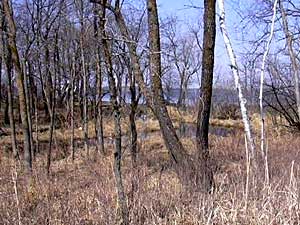|
Audio
Photos
Resources
Your Voice
|
Phosphorus levels threaten Big Detroit Lake
May 13, 2003
 |
| Sucker Creek empties into Big Detroit Lake. Officials hope buffer zones like this one will curb the runoff of nutrients like phosphorus into Detroit Lake. (MPR Photo/Bob Reha) |
Detroit Lakes, Minn. — Lakes can be like people. They need a certain amount of food to remain healthy. One key source of nutrition for a lake is phosphorus, which occurs naturally. Phosphorus feeds aquatic plants. But like humans, when lakes get too much food, bad things happen. Bruce Wilson is a research scientist studying Big Detroit Lake.
"One pound of phosphorus, theoretically, can produce up to 500 pounds or so of algae or excess plants in the lake," says Wilson.
Wilson, who works for the Minnesota Pollution Control Agency, says right now, Big Detroit Lake looks fine. But development around the lake is on the rise. That means more nutrients will feed into the lake.
 | |||
If the lake loses its natural buffer, runoff can damage water quality. Wilson says with less natural habitat, the lake will be overrun with weeds, and it will go from a picturesque blue to a scummy brown. Wilson says if water quality suffers, so will the local economy.
"These are huge economic centers for travel and tourism, and we're in an economic competition with other parts of the country," says Wilson. "If we don't have good water quality, people are going to go somewhere else."
Phosphorus comes from many sources. One of the main contributors is fertilizer used on crops and lawns.
Tera Guetter, administrator of the Pelican River Watershed District, says it's important to let people know what they can do. Simple things, like natural landscaping, can improve a lake's water quality. But many natural landscapes have vanished.
"Mud ponds or swamp ponds are being developed into lakeshore property, and being sold as prime lakeshore property, so that's a problem," says Guetter. "We're seeing development pressures that we never even dreamt about 10 years ago."
 | |||
Guetter says 10 years ago, those marginal lakes acted as buffers -- places where the phosphorus collected before it reached Detroit Lake. Now, homes built in those buffer zones are a new source of phosphorous.
Guetter is working with local officials and developers to address the problem. Some 30 years ago there were no zoning laws along Detroit Lake, but times have changed.
Tera Guetter drives along the lakeshore, pulls her truck to the side of the road, and stops.
"This is Sucker Creek, our trout stream, that discharges into Big Detroit. This is one of the innovative planning commission and city council decisions," says Guetter. "Allowing the structures to be built, where we've placed a permanent easement between the trout stream and the structures." Guetter says new zoning laws require developers to include easements or buffer zones in their projects. The laws encourage leaving a part of a lot in its natural state.
It's all part of a goal to reduce nutrient runoff into the lake. Guetter says a finely-manicured lawn might look nice, but it increases the flow of phosphorus into the water.
 | |||
Don Busker is a civil engineer who has worked on many lakefront developments. Busker says runoff is a concern, but he worries the new laws will take money out of developers' pockets.
He cites one recent project as an example. A developer built a large holding pond in a new residential development, essentially cutting into his own profit to make the change. That "protective district" prevents nutrients from ultimately running into Detroit Lake.
"By making a special protective district, he eliminated one lot and also three adjacent lots were reduced in size," says Busker. "So he in essence, he eliminated one lot and reduced the value of the other three lots."
Busker says those changes cost the developer between $30,000 and $50,000. He thinks the developer should receive some compensation for that cost.
But there are larger issues involved. Busker says the new laws should be applied to everyone with lakeshore property.
"We tell the developer, 'You've got to restrict the runoff into the lake,' and other regulations," says Busker. "But the people next door are grandfathered in, and they are not required to follow any restrictions."
Busker says having the law applied equally is the key to solving the runoff problem.
|
News Headlines
|
Related Subjects
|
